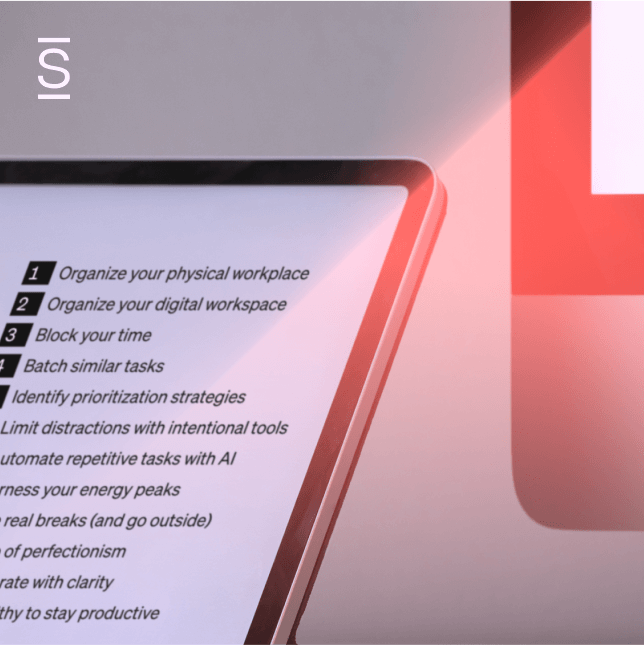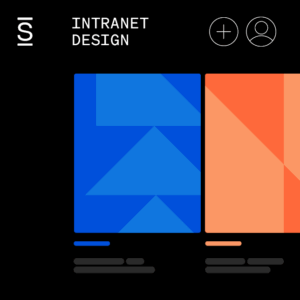If you’re searching for the best intranet platform, you don’t want to base your investment on a handful of anecdotes. You want a comprehensive review of the market that includes robust, independent research methodologies.
This article offers precisely that, broken down into the following sections:
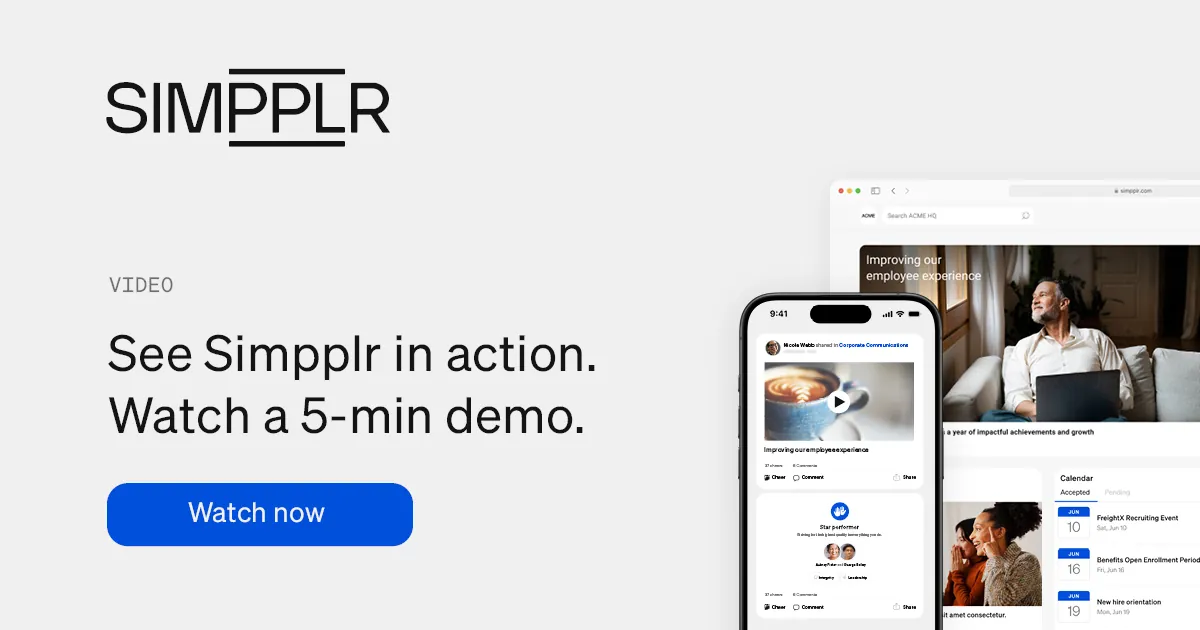
Choosing the best intranet platform: Analyst reports approach
Let’s drill into review methodology — we used authoritative analyst reports to compare the best intranet platforms. The reports include:
- Q4, 2024 Gartner® Magic Quadrant™ for Intranet Packaged Solutions
- Winter, 2025 G2 Grid® Report for Employee Intranet
Understanding analyst reports
Analyst reports are independent, in-depth evaluations of industry-leading solutions — in this case, for intranet software. The strength of these reports lies in clear metrics and methodologies.
The Gartner® Magic Quadrant™ is a research methodology and graphical representation that provides an analysis of a market’s direction, maturity, and participants on completeness of vision and the ability to execute that vision. It is published by Gartner, Inc., a global research and advisory firm that specializes in providing insights and analysis for various technology-related markets.
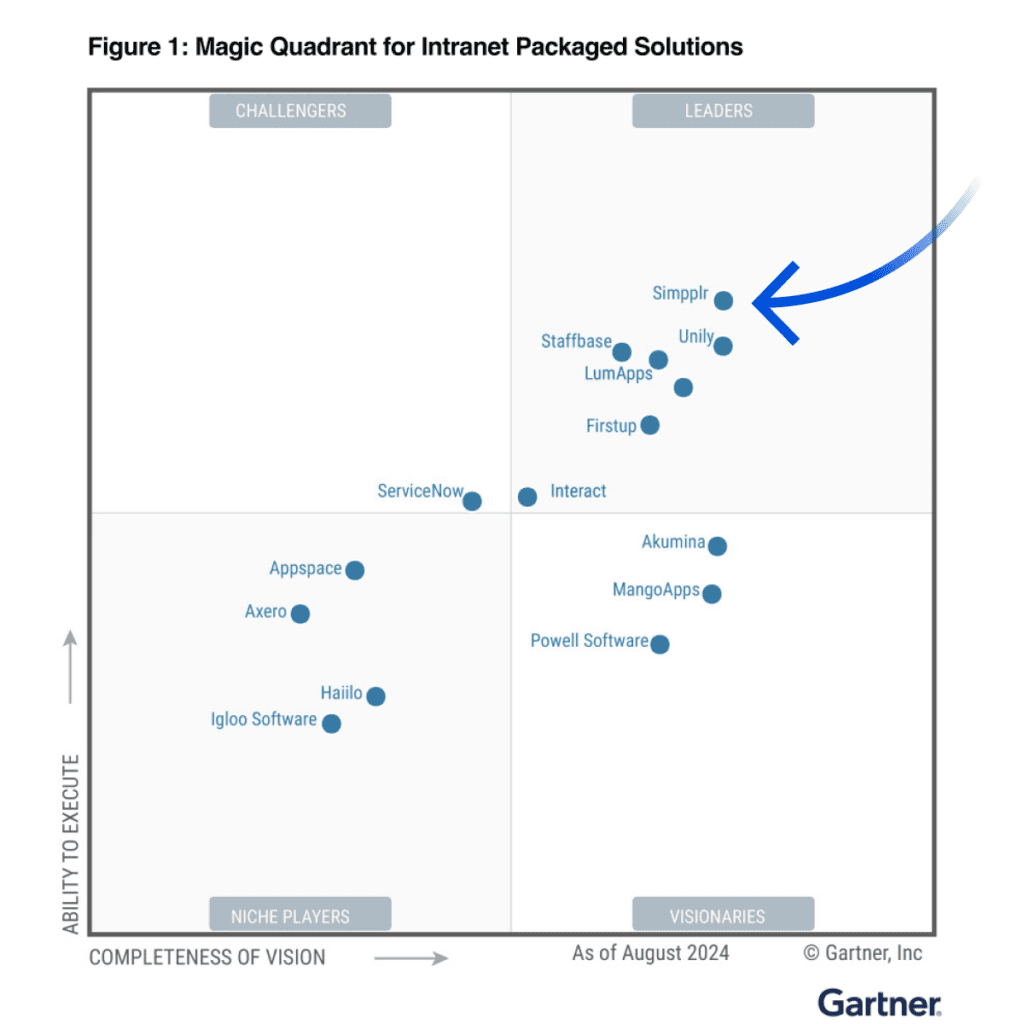
The Forrester Wave offers a consistent methodology and transparent scoring across two axes: strategy and strength of current offering.
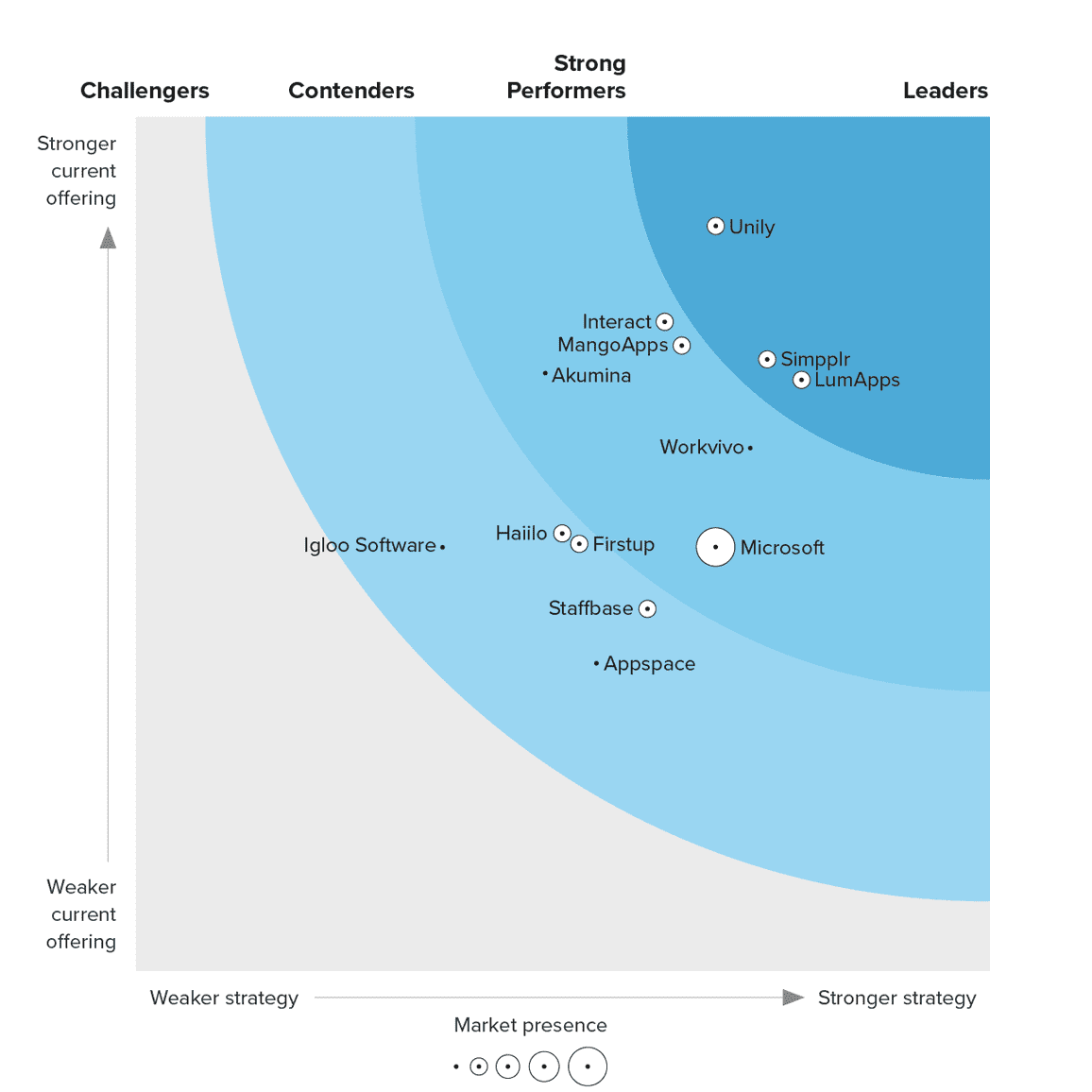
G2 uses a proprietary scoring algorithm based on structured, user-generated ratings across a variety of variables as well as open commentary and reviews.
Intranet platform selection: Key criteria and requirements
The Gartner Magic Quadrant report is very specific regarding key criteria and requirements, requiring them to be cohesive, cloud-based products specifically designed for intranet use cases. Solutions had to include content services, integration capabilities, personalization, analytics, workflow automation, a common UI framework, multiexperience support, and security and access management. Offerings that relied on additional platforms or lacked these essential features were excluded.
The Forrester Wave report includes only cloud-first intranet platforms with a minimum annual product revenue of $10M, marketed as solutions for intranet and employee communications, scalable to 5,000+ employees, and with active interest among Forrester clients.
The G2 report differs in that it is based on customer-based reviews (vs. reviews based on analyst research). It allows software to be included in multiple categories, and that includes software that’s designed for building intranets along with packaged solutions, as well as software that merely touches on the category rather than being holistic intranet solutions.
Guidelines to select the ideal intranet software
The best intranet software should be considered a leader by both independent evaluators with strict methodologies and G2, which gathers real-world user ratings.
Top 7 intranet platforms and solution providers reviewed:
Leveraging data from these industry-leading reports, here’s an in-depth analysis of the seven top intranet platforms. Based on the independent analyst reports, the best intranet platform providers are:
- Simpplr
- Unily
- Workvivo
- LumApps
- Staffbase
- Interact
- Igloo
1. Simpplr: The Leader across all three reports
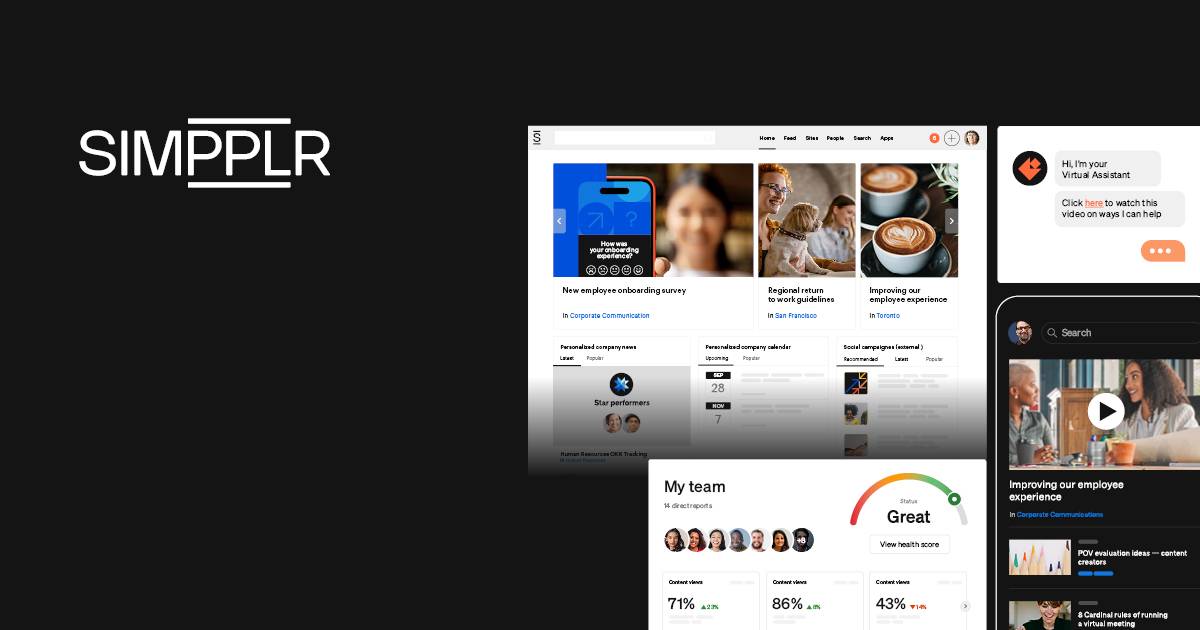
Simpplr per Gartner MQ
According to Gartner, Simpplr continues to dominate as a Leader, excelling in both “completeness of vision” and “ability to execute.” It offers a comprehensive intranet experience out of the box for desk, frontline and contingent workers, encompassing social, communication, collaboration and knowledge management tools.
Simpplr’s key strengths include:
- Strong out-of-the-box functionality reduces reliance on IT and enables rapid deployment.
- High customer satisfaction with search, content governance, and ease of use.
- Excels in delivering a unified, personalized employee experience across all roles.

Simpplr per Forrester Wave
In the Forrester report as well, Simpplr is recognized as a Leader for its strong strategy and impressive current offering.
Simpplr received perfect scores of 5 for adoption and innovation, the highest among leaders, showcasing its commitment to employee experience.
Simpplr received the highest scores possible for AI and machine learning and several other key criteria, including metadata support, governance, dashboards and reporting, developer resources, and surveys. Its lowest scores were for market presence — number of customers and revenue, both of which are expected to rise as more companies discover Simpplr’s industry leadership.
According to the Forrester report, “Simpplr has strong AI/ML capabilities that facilitate deep personalization of an employee’s news feeds based on role, topic, or other context to deliver relevant information. Other strengths include automation of content governance, rich metadata, and reporting tools. Areas of weakness include native collaboration tools, with thin offerings for team workspaces/communities of interest.”
The bottom line? “Forrester recommends Simpplr for large and midsize enterprises seeking a cutting-edge cloud intranet within the Google or Microsoft ecosystem. Organizations with over 1,000 employees, including remote and mobile workers, should consider Simpplr for its exceptional AI and communication capabilities.”
Simpplr per G2
In G2, only eight of the intranet contenders appear in the top quadrant, meaning they’re strong in both user satisfaction and market presence. While Microsoft’s SharePoint is at the top-right of the grid — it is for building an intranet, not buying one. Moreover, Simpplr’s ratings lead SharePoint’s by quite a bit across all four of the user satisfaction categories reported. Simpplr received overall user ratings of:
- 9.4: Quality of support
- 9.5: Ease of use
- 9.5: Being a good partner in doing business
- 9.1: Ease of administration
SharePoint, by comparison, received scores of 8.2 for quality of support, 8.0 for ease of use, 8.4 for being a good business partner, and 7.9 for ease of admin.
2. Unily
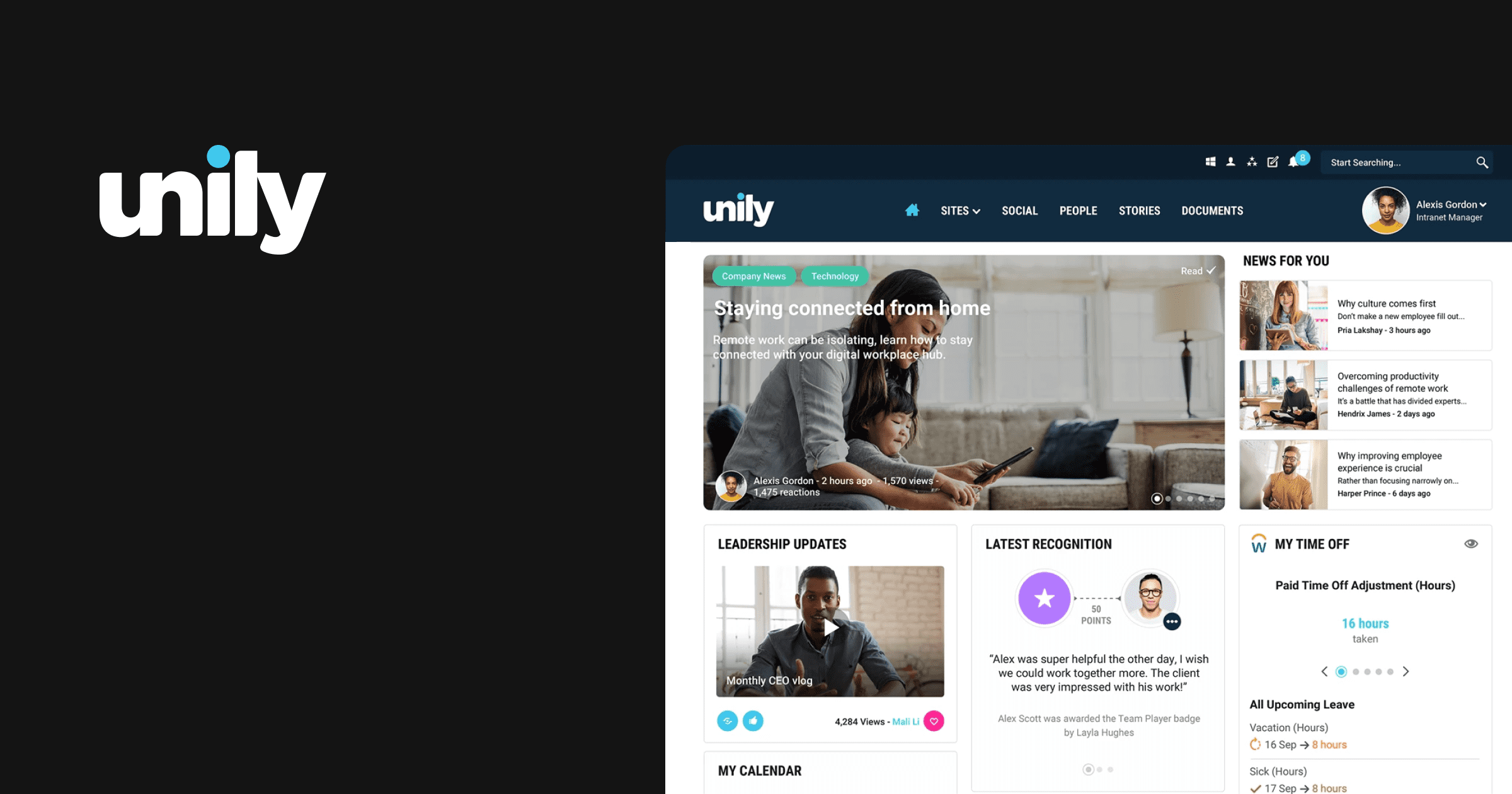
Unily per Gartner MQ
According to Gartner, UK-based Unily offers several strengths despite ranking behind Simpplr in its ability to execute in the Leader quadrant. Its focus on scalability and operational flexibility makes it a popular choice for organizations with complex intranet needs. However, its offerings are less accessible for companies under 10,000 employees.
Unily’s key strengths include:
- Comprehensive content management and personalization capabilities.
- Supports large-scale deployments with robust operational configurations.
- Strong focus on frontline worker needs and global organizations.
Gartner cautions, however, that work and task management is not as comprehensive as some competitors, especially for frontline and hybrid workers. It also reports that customer support is sometimes slower than expected.
Unily per Forrester Wave
Unily is ranked among the leaders in the Forrester report, excelling in current offerings and strategy. Launched initially as a SharePoint add-on, Unily has evolved into a robust cloud-native intranet and internal communication platform for global enterprises. According to Forrester, “Unily’s strengths include a well-resourced roadmap that its customers influence, focuses on automation, broadens its application integrations, and improves data insights. Areas of weakness include native collaboration that offers support for communities and frontline worker coordination but depends on integrations with third-party tools such as Microsoft Teams, Slack, or digital whiteboards.” Reference customers also reported “some concern about extra costs for new features.”
Unily per G2 Grid
Among G2 reviewers, Unily did not rank in the top quadrant. In G2’s four user satisfaction categories, Unily’s overall user ratings were below Simpplr’s ratings across the board, although Unily was only slightly behind Simpplr in ease of use:
- 8.8: Quality of support
- 9.5: Ease of use
- 8.6: Being a good partner in doing business
- 8.6: Ease of administration
3. Workvivo
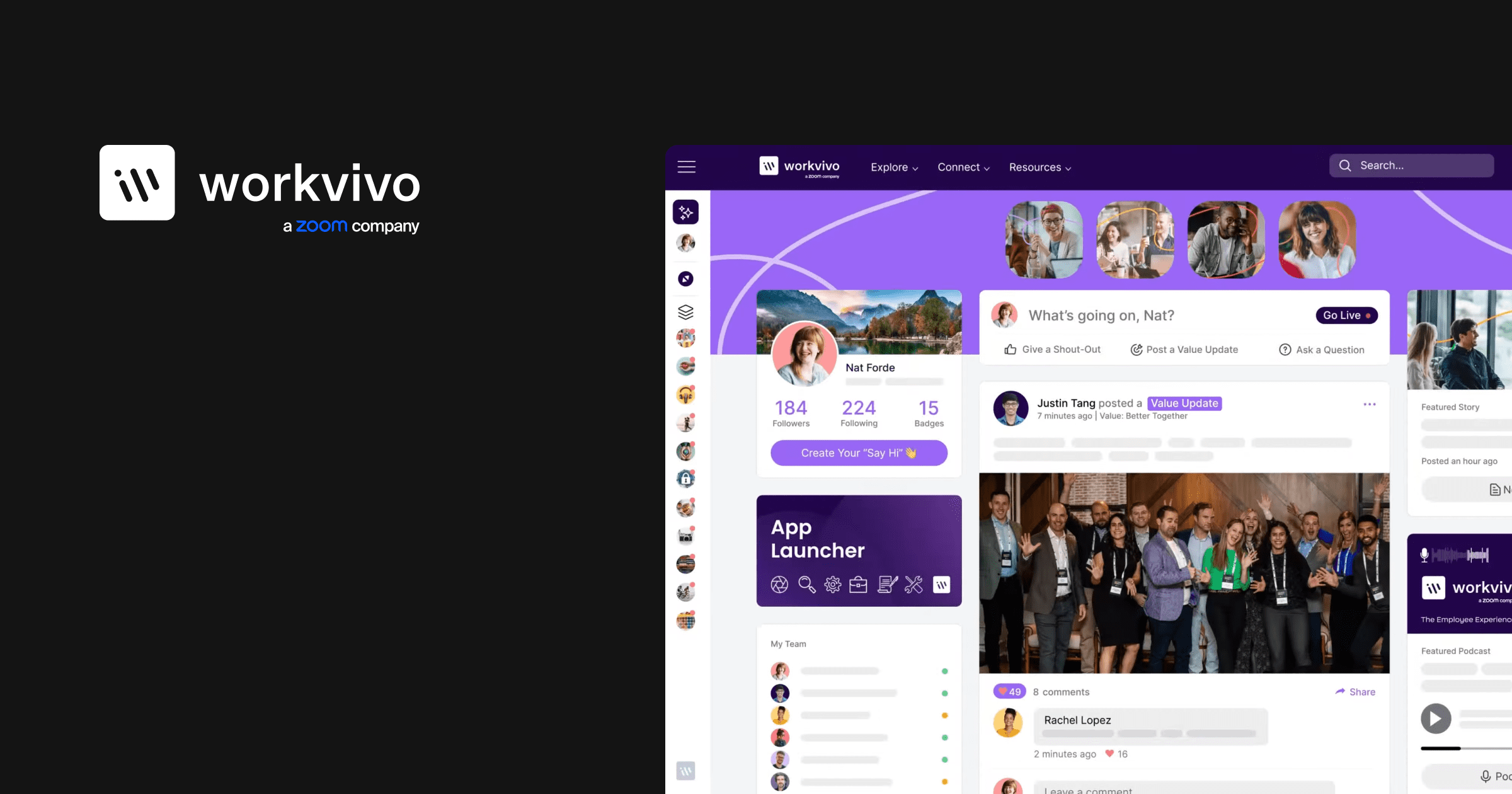
Workvivo per Gartner MQ
Workvivo is a Leader in the Gartner report through its focus on social communication and employee engagement. Acquired by Zoom, the platform has significantly expanded its reach and capabilities, leveraging Zoom’s real-time communication tools to enhance its value proposition.
Workvivo’s key strengths include:
- Strong social and multichannel communication capabilities enhanced by Zoom integration.
- Expanded market presence due to strategic partnerships like Meta’s Workplace migration.
- Innovative in offering real-time communication tools for town halls and events.
Gartner cautions that Workvivo’s overemphasis on social communication may not align with organizations prioritizing work management. Also organizations standardizing on Microsoft may hesitate due to platform alignment.
Workvivo per Forrester Wave
Forrester recognized Workvivo as a strong performer. Acquired by Zoom in 2023, Workvivo faces the challenge of maintaining balance across its priorities, such as expanding integration for clients in the Microsoft 365 ecosystem, while capitalizing on new bundling opportunities across the Zoom portfolio. According to Forrester, “strengths include integration with major productivity suites, employee survey tools such as templates and builders, as well as trend reports. Weaknesses include the breadth of its developer resources and support for an AI-based intelligent agent, which was not generally available at the time of this evaluation.” Reference customers tend to be “less happy with workflow automation such as journeys and the breadth of developer tools.”
Workvivo per G2 Grid
Workvivo was included in the top quadrant of the G2 report with high user ratings:
- 9.7: Quality of support
- 9.7: Ease of use
- 9.9: Being a good partner in doing business
- 9.6: Ease of administration
4. LumApps
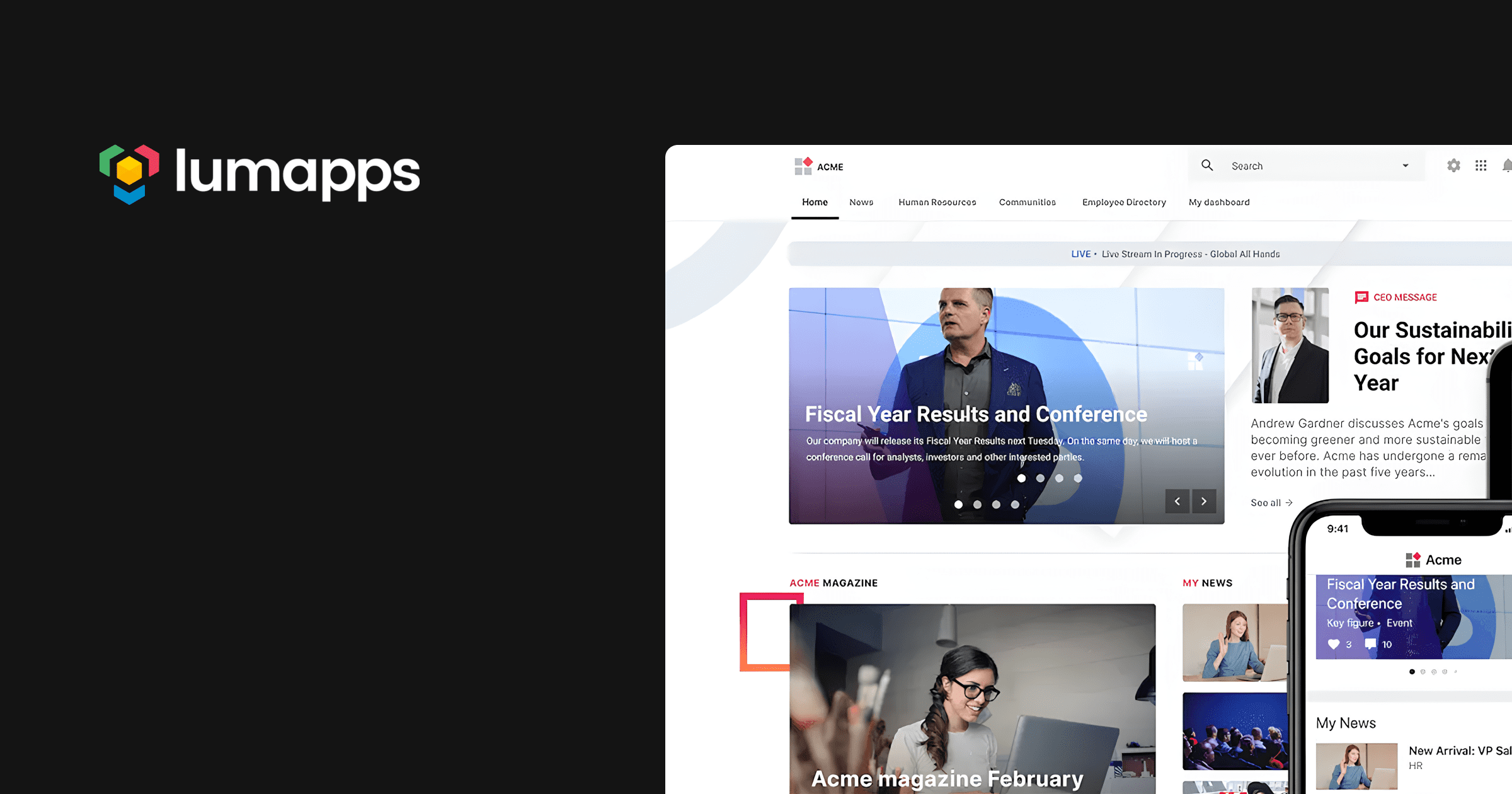
LumApps per Gartner MQ
France based LumApps was included as a Leader in the Gartner report. The platform appeals to organizations looking for a diverse, scalable solution but requires significant effort for deployment and customization.
LumApps’ key strengths include:
- Strong multichannel communication capabilities with AI enhancements.
- Extensive integration portfolio with over 100 connectors to major enterprise platforms.
- Tailored vertical solutions supported by industry-focused partnerships.
Gartner cautions, however, that LumApps requires significant effort in deployment, development, and design. Customers seeking out-of-the-box simplicity may prefer alternatives. Also, their Partner ecosystem expansion is ongoing and may limit support options in some regions.
LumApps per Forrester Wave
In Forrester, LumApps is recognized as a leader alongside Simpplr and Unily. While it ranks closely to Simpplr in current offerings, it slightly trails behind (3.46 for LumApps compared to 3.58 for Simpplr). According to Forrester, “LumApps has strong capabilities including reporting, application integration, metadata, search, and workflow-driven employee journeys. It lags in survey capabilities, which offers basic user feedback and voting but rely on third-party tools for advanced surveys and trending.” Reference customers reported less satisfaction, “with an ‘overwhelming’ pace of new-feature rollout and add-on costs.”
LumApps per G2 Grid
In G2, LumApps did not make the top quadrant, and its user ratings fell below industry averages in every category:
- 8.3: Quality of support
- 8.5: Ease of use
- 9.0: Being a good partner in doing business
- 8.5: Ease of administration
5. Staffbase
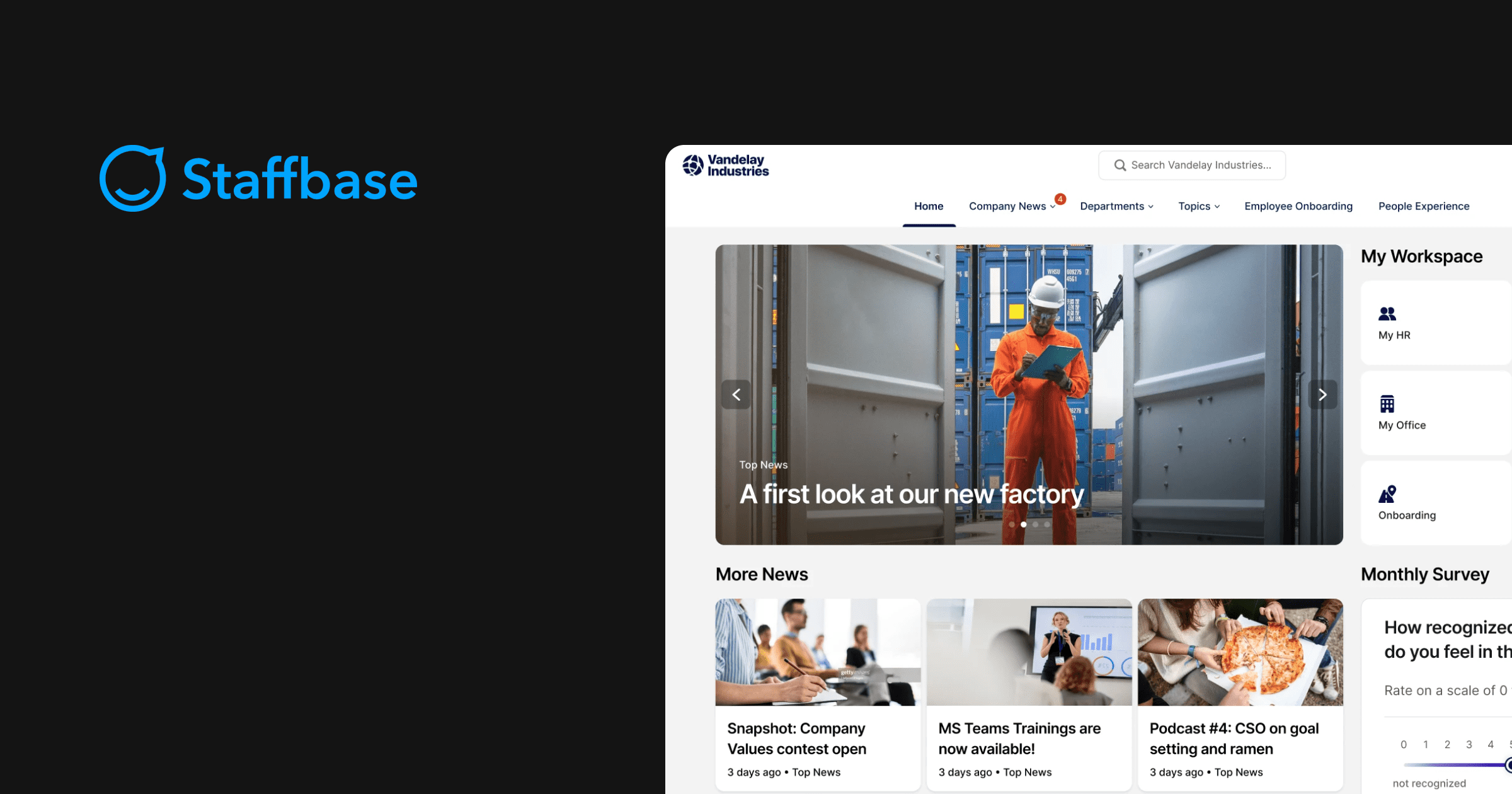
Staffbase per Gartner MQ
Gartner reports particular intranet platform strengths for Staffbase in its integration with Microsoft. Its unified desktop and mobile solution, coupled with strong administrative features, has earned it high customer satisfaction. The platform is well-suited for organizations undergoing digital transformation.
Staffbase’s key strengths include:
- Focused on employee communications and integration with Microsoft tools.
- Unified solution for desktop and mobile users with excellent administrative features.
- Recently introduced metrics and dashboards to measure intranet performance.
Gartner cautions that its analytics, notifications, and search functionalities require improvement. Gartner also notes that Staffbase’s regional focus is predominantly in Europe, with limited data sovereignty support in other regions.
Staffbase per Forrester Wave
Staffbase was included in the Forrester report as a contender, highlighting its strong communication features but indicating a need to enhance core intranet functionalities. Staffbase excels in internal communication features, such as calendaring, audience segmentation, SMS support, and editing tools for email newsletters. However, it faces challenges with “limited content governance capabilities, options for content approval workflows, native file, and media management tools, as well as reporting on content freshness.” Reference customers express dissatisfaction with documentation for developers and find several aspects of its packaged reporting tools lacking.
Staffbase per G2 Grid
Staffbase appeared in the top quadrant of the G2 report with strong user satisfaction ratings:
- 9.4: Quality of support
- 9.3: Ease of use
- 9.6: Being a good partner in doing business
- 9.2: Ease of administration
6. Interact
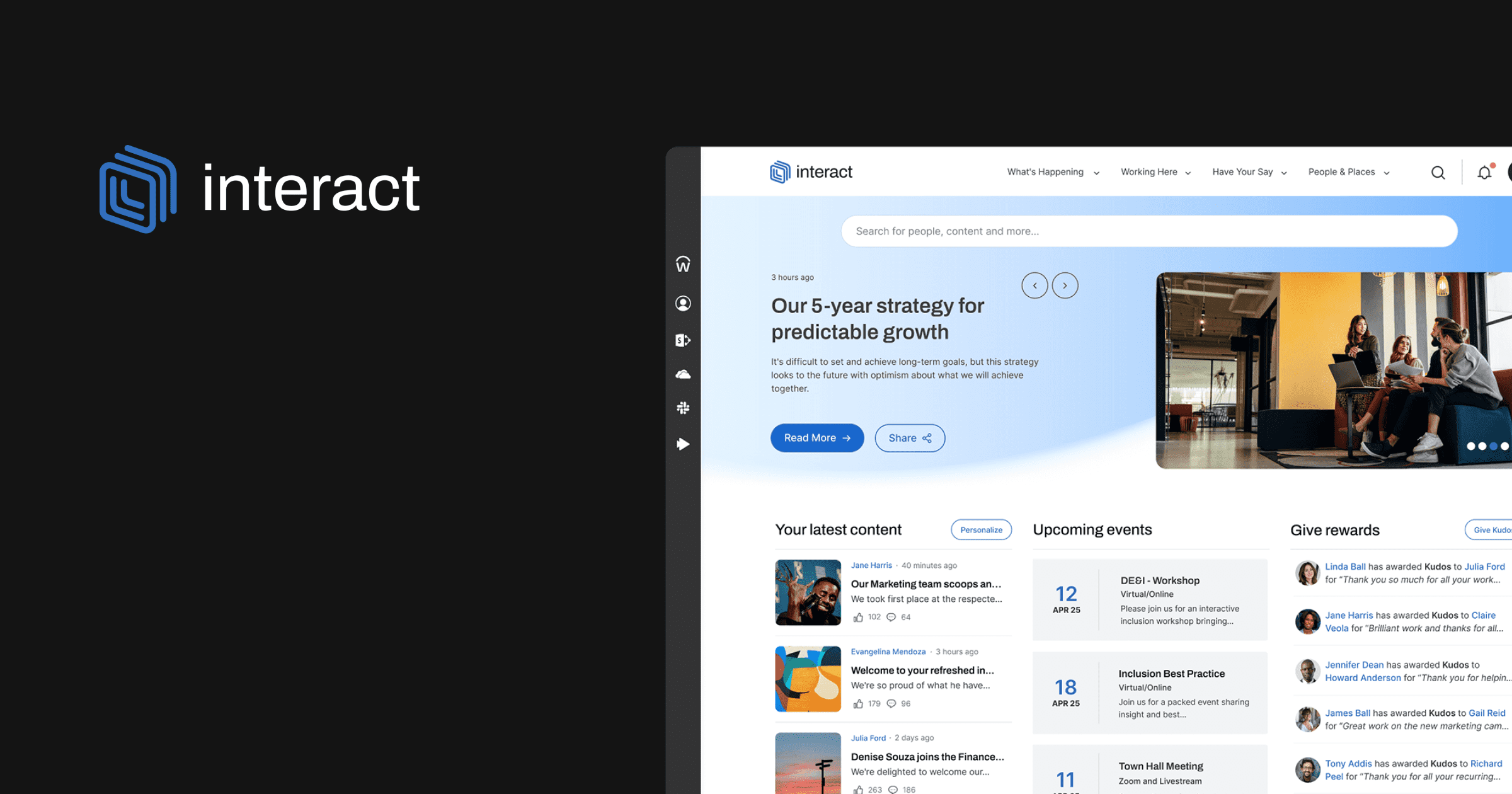
Interact per Gartner MQ
Interact has solidified its position as a Leader with a strong emphasis on customer collaboration and innovation. Its deep understanding of client needs and investments in GenAI enhance its appeal, especially in verticals like healthcare and financial services.
Interact’s key strengths include:
- Deep understanding of customer goals during sales and deployment phases.
- Strong presence in specific verticals like financial services and healthcare.
- Continues to innovate with GenAI-driven employee experience enhancements.
Gartner cautions that Interact struggles to differentiate its multichannel communication and content management capabilities from competitors. Organizations outside its core industries, such as healthcare and retail, may find its offerings less tailored to their needs and should carefully assess its support for broader use cases. Furthermore, its social and community features are less advanced, which may reduce its appeal for those seeking a more comprehensive employee engagement platform.
Interact per Forrester Wave
In the Forrester report, Interact came in 4th overall as a “strong performer” but not an industry leader. According to Forrester, “Interact has rich capabilities and adoption services but must raise brand recognition.” Forrester also reported strengths in “repository services, search, metadata, personalization, and design tools” but highlighted shortcomings like “lack of support for complex process-driven employee journeys or multistage campaigns.” Customers were highly satisfied with its overall content authoring tools, search, and professional services but were “less satisfied with the reporting capabilities and complexity of some UIs and administrative interfaces.”
Interact per G2 Grid
Interact appeared in the bottom quadrant of G2 despite decent ratings in the four user-satisfaction categories (albeit from only 33 total reviewers):
- 9.1: Quality of support
- 9.2: Ease of use
- 9.1: Being a good partner in doing business
- 8.5: Ease of administration
7. Igloo
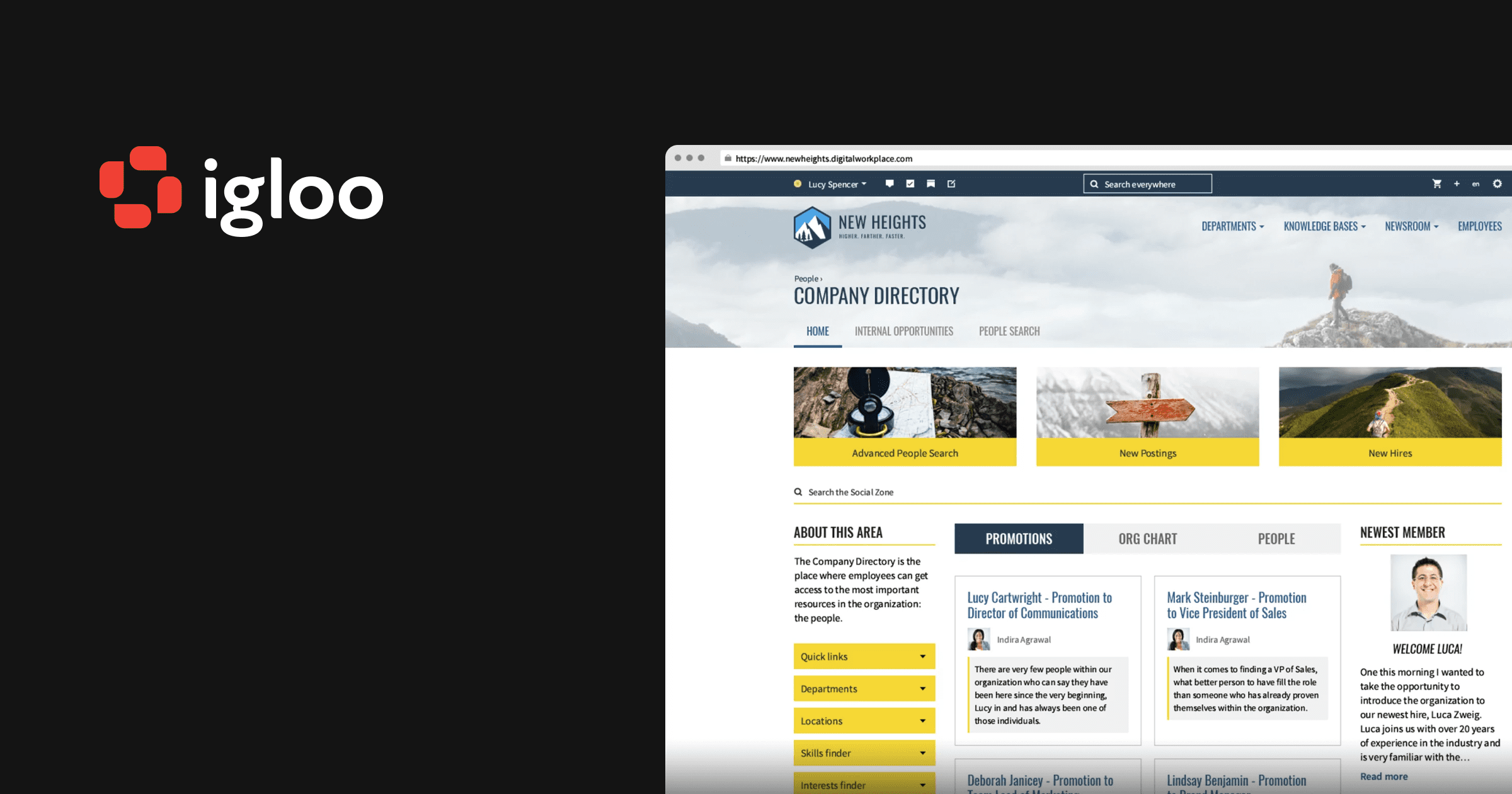
Igloo per Gartner MQ
Igloo remains a Niche Player, delivering reliable customer support and cost-effective solutions for budget-conscious organizations. While it excels in providing insights and benchmarking, it struggles to compete in innovation and mobile experiences compared to Leaders.
Igloo’s key strengths include:
- Highly rated for customer support and relationship building.
- Cost-effective pricing attracts budget-conscious organizations.
- Offers a monthly insights program and benchmarking services for intranet maturity.
Gartner cautions that Igloo faces challenges in innovation, particularly in its mobile offerings and enterprise search capabilities, which lag behind competitors. Additionally, the platform’s user interface lacks the immersive experience provided by other vendors, and its ability to meet region-specific compliance and data sovereignty requirements may require closer evaluation by prospective customers.
Igloo per Forrester Wave
Igloo was included in the Forrester report as a challenger but significantly lagged behind other vendors. Forrester emphasized that Igloo “must not lose focus on fundamentals.” While Forrester praised its content governance for driving approval or retirement actions, design capabilities for branding, and libraries of solution templates for onboarding or knowledge management, weaknesses were noted in “survey and employee advocacy capabilities.” Igloo’s classic intranet platform falls short in “support for writing assistants and other genAI capabilities.”
Igloo per G2 Grid
The solution appears in the bottom quadrant of G2, with user satisfaction ratings that are all below industry averages:
- 8.7: Quality of support
- 8.6: Ease of use
- 8.5: Being a good partner in doing business
- 8.3: Ease of administration
Final verdict: Trade-offs and top picks
Best intranet platforms
The results are clear — Simpplr is the only intranet software that was consistently named a leader across all three reports. If your organization needs a complete, industry-leading intranet solution, both experts and customers strongly recommend Simpplr’s platform.
Get a live demo of Simpplr.
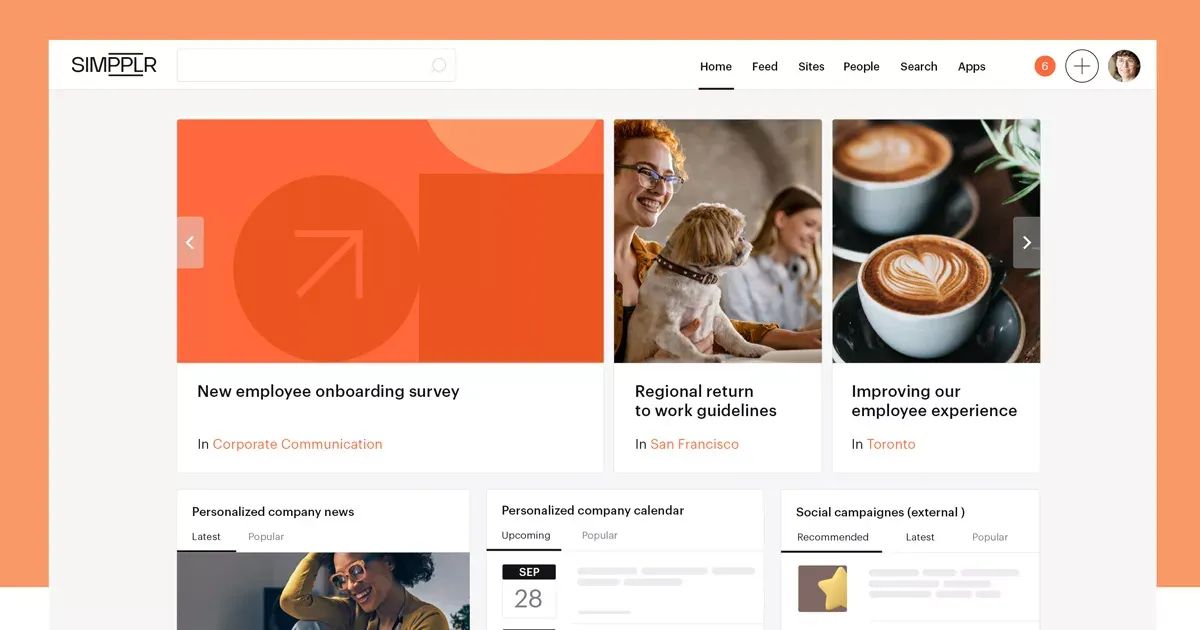
Trade-offs: What you should consider
Despite these results, not every business needs a complete intranet solution. For smaller businesses that simply need better communications, a messaging system like Slack might serve your purposes well as you grow. The following trade-offs are important to consider as you weigh your options.
Cost vs. value: How much does intranet software cost?
At the end of the day, every business decision comes down to ROI. What return or benefit will your organization see from its investment?
A Forrester study designed specifically to weigh the economic impact of implementing Simpplr calculated the following:
- A total three-year ROI of 283% for the composite organization
- $2.1 million in recaptured productivity from helping employees find resources faster
- $1.2 million in productivity gains from reducing the volume of emails
- A 70% reduction in IT bandwidth used toward administering the intranet and supporting the internal comms team
Read the full Forrester economic impact report
Business needs vs. platform features
To make sure you’re maximizing your ROI, start by evaluating your internal needs. If your organization is still relatively small, it might just need a messaging platform or a product management tool. You might not need a fully integrated intranet solution. Significant ROIs from intranet software are more likely in both hard and soft returns for midsize to enterprise organizations.
Learning curve vs. intuitive use
One of the most important aspects of intranet platform implementation is that ROI follows adoption. If your intranet ROI is expected to flow from gains in efficiency and productivity, then your maximum gain requires widespread usage. The longer your intranet takes for employees to learn, the less likely it is that they’ll use it. So be sure to compare adoption rates across any platforms you consider.
Stay connected and aligned with a modern intranet
A modern intranet is the nerve center of your organization, driving productivity and efficiency.
Keep your teams aligned and connected with a modern intranet platform that’s powered by AI, as easy to use as talking, and accessible through a phone app that can fit in every employee’s pocket.
Most importantly, make sure you’re signing up with an industry leader that’s known for smart, fast innovation — one that can keep up with the speed of technology and keep you ahead of the curve, both today and tomorrow.
Reach out for a live demo, or watch a quick 5-minute demo to see Simpplr in action.

Watch a 5-minute demo
See how the Simpplr employee experience platform connects, engages and empowers your workforce.
- #1 Leader in the Gartner Magic Quadrant™
- 90%+ Employee adoption rate
Employee intranet software review snippets about Simpplr
When testing the platform, we found a 50% increase in efficiency when individuals searched for onboarding materials.
Wendy M. Pfeifer CIO, Nutanix
Future State’s highly distributed workforce requires effective communication across our team. Simpplr’s easy-to-use and visual digital workplace platform has enabled us to significantly increase our communications efficiency and empower our employees to connect with each other.
Kathy Krumpe COO, Future State
Simpplr is easy to use, deploys quickly, and requires minimal training making the intranet platform a necessity in the digital workplace. Simpplr has saved us time, money, and helped decrease Crowdstrike’s IT tickets.
Chris Lewis Senior Manager, Security Engineering, Crowdstrike
Employee intranet software FAQs
What is an intranet? Definition of intranet software
Intranet software is an application that drives a private network system (an intranet) used within a company or organization. It’s designed to serve as a centralized portal for employees to share information, collaborate on projects, and increase productivity. Much like the internet, the intranet enables users to share and view files, but with a higher level of security and privacy. Only employees and other organizational stakeholders can access the intranet, and each user is assigned specific permissions.
What are intranet platforms?
Intranet platforms are intranet software solutions that can deploy an intranet for an organization. The terms intranet platform, intranet software and intranet solution are used interchangeably throughout this article.
The advantages of using an intranet
An intranet offers many organizational advantages — starting with efficient communication, secure information exchange and improved collaboration. An intranet can also be a great tool for onboarding, training, shaping corporate culture, and sharing resources.
Ultimately, the right intranet enhances productivity and can contribute significantly to an organization’s success.
An intranet offers many organizational advantages — starting with efficient communication, secure information exchange and improved collaboration. An intranet can also be a great tool for onboarding, training, shaping corporate culture, and sharing resources.
Why choose the best platform for your intranet?
There are three intranet software differentiators that can significantly impact your organization’s return on investment (ROI):
- The type of intranet software (building vs. buying)
- The features it offers (from basic to advanced)
- Design and integrations (for widespread adoption)
The following sections walk through each differentiator.
The two main types of intranet software
Modern intranet platforms integrate with myriad solutions for communications, collaboration, project management, HR management, document sharing and much more. They can even offer AI interfaces that let employees handle routine tasks like scheduling vacation time or uploading expenses by speaking or chatting naturally on their phone — in over 130 languages.
Given the extreme specialization of today’s best intranet platforms — and the resources required to build and maintain them — most companies see a far better ROI from partnering with a dedicated third-party intranet provider.
Learn more about employee intranet software: Features that matter
Employee intranet software features
Traditional intranets are associated as being communications or productivity solutions, such as internal messaging or project management.
In fact, intranets today are built to address broader employee experience challenges.
The best intranet platforms will connect your employees to (and integrate with) all the essential tools they need in a single communications portal:
- Company news and communications
- Internal messaging
- Video management
- Information management
- Project management
- Document management
- Human resources software
- Data collection, storage and analysis
Additional employee intranet features
When it comes to modern intranet platforms, the list above represents “table stakes” — the bare minimum required to be considered an effective intranet platform. The following additional features take an intranet platform further, distinguishing it from competitors:
- Auto-Governance Engine: An intranet should be able to monitor for out-of-date content so its usefulness doesn’t diminish over time.
- Federated Search: Search functionality should be personalized and powered by artificial intelligence (AI) to help users find exactly what they need quickly and easily.
- Employee Listening: Your intranet should leverage AI to unearth key insights in real time, keeping your finger on the pulse of employee sentiment.
- Native Video: Given the importance of video in news, onboarding, training and more, a top intranet platform should offer integrated video capabilities.
- Personalized Feeds: Like today’s most engaging social media, your intranet should surface content that’s uniquely interesting to each individual employee.
- AI Virtual Assistant: At the cutting edge of AI, your intranet should let users talk to or chat with it in their own native language (over 133 and counting).

How do I get employees to use an intranet?
To maximize the ROI of your intranet implementation, user adoption is everything.
No matter how great your intranet looks on paper, it can’t improve your teams’ efficiency and productivity if they aren’t using it. And a poor user experience is one of the top 10 reasons intranets fail.
That’s why we can’t overstate the importance of user-friendly features and an easy-to-use, mobile-friendly design. The ideal intranet includes an app that works natively on the devices your employees carry around in their pockets.
Employee intranet user satisfaction
The other thing you can’t overlook is the list of plug-and-play integrations. A successful intranet rollout depends on your intranet software integrating with the popular solutions your employees already use — Slack, Zoom, Google Drive, Dropbox, Workday, Google Analytics, LinkedIn and more.
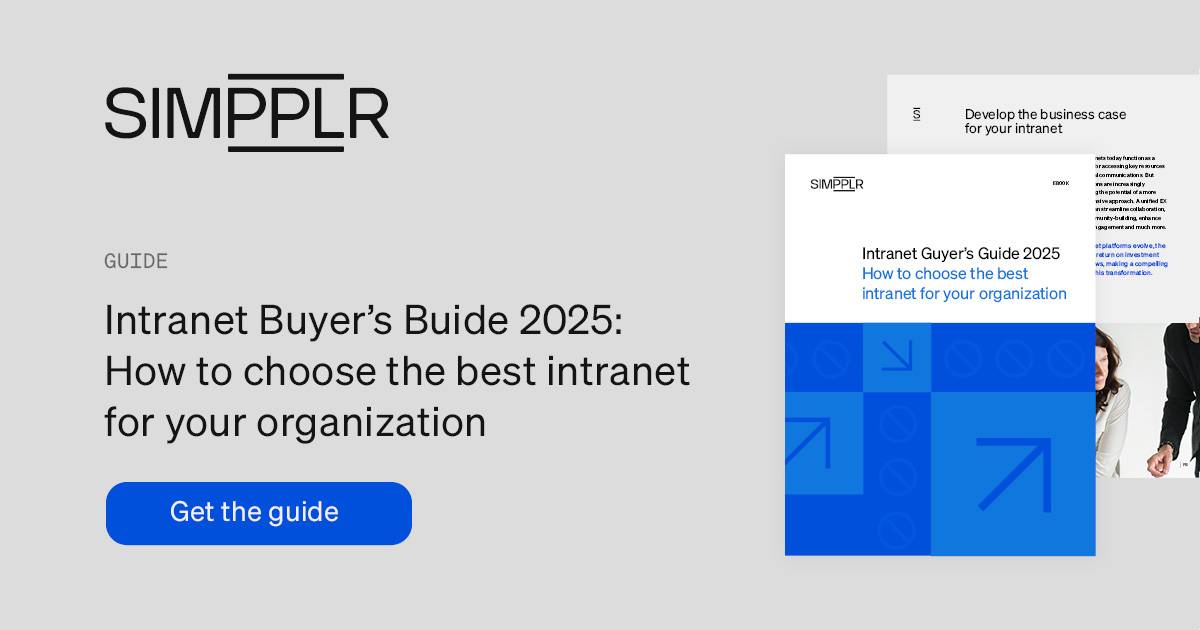
Employee intranet software FAQs for enterprise companies
Why do you need an enterprise intranet?
When evaluating intranets for enterprise use, it’s important to consider various factors. The needs of enterprises can vary, but here are important considerations:
- User experience: How intuitive is the user interface? Is it flexible to meet the specific needs of different departments, teams, and employee segments?
- Collaboration and communication: Does the intranet facilitate seamless collaboration among team members? What communications tools are integrated? Can users share documents and projects within the intranet?
- Integrations with existing systems: How well does the intranet integrate with existing enterprise applications (e.g., HR software, CRM, IT, knowledge management)
- Content management: How easy is it to create, edit, manage, and update content on the intranet? Is there automation to streamline processes?
- Security and compliance: What security measures are in place to protect sensitive data and ensure user privacy? Are there audit trails and access controls to monitor and manage user permissions?
- Scalability and performance: Can the intranet scale to accommodate organizational changes? What is the performance track record?
- Analytics and reporting: Does the intranet provide analytics and reporting features to track user engagement and content effectiveness? What insights can it provide to analyze the employee experience?
- Training and support: What training resources and documentation are provided?
- Cost and ROI: What is the total cost of ownership? How quickly can my organization expect to see a return?
- User adoption: Have other organizations of similar size and industry successfully adopted the solution? What is recent user feedback from current users?
- Future roadmap and innovation: What does the roadmap look like for future updates and improvements? How often are vendor release updates and what is the process for implementation?
Read our Intranet Buyer Guide for a roadmap to help guide you through the intranet buying process.
Should we build an intranet or buy an out-of-the-box solution?
Building means building from scratch an IT-configured solution for your enterprise needs and maintaining it through internal resources. This takes time and resources. On the other hand, an out-of-the-box intranet solution like Simpplr is designed to require minimal IT involvement. This means quick implementation and easy administration by your Internal Comms team. Explore the full benefits and drawbacks of buying vs building an intranet.
Employee intranet software FAQs for IT professionals
This section answers commonly asked questions about employee intranet software by IT. It covers a broad range of topics from installation and operation to troubleshooting and productivity enhancement tips, offering valuable information for industry professionals.
Is Simpplr’s intranet SOC 2 and SOC 3 compliant?
Yes and yes! Learn more about Simpplr’s security compliance.
How much lift from IT is needed to implement and manage Simpplr’s intranet?
Minimal. Simpplr research has found that delayed deployments are a top reason that intranets fail. Thus, Simpplr was developed to be easy and fast to deploy and requires no IT management after deployment. Ask these questions when considering new intranet software:
- How well does the intranet integrate with existing enterprise applications (e.g., HR software, CRM, IT, knowledge management)?
- Scalability and performance: Can the intranet scale to accommodate organizational changes? What is the performance track record?
- Analytics and reporting: Does the intranet provide analytics and reporting features to track user engagement and content effectiveness? What insights can it provide to analyze the employee experience?
- Training and support: What training resources and documentation are provided?
- User adoption: Have other organizations of similar size and industry successfully adopted the solution? What is recent user feedback from current users?
Solutions other than an intranet to consider, for small businesses
Choosing the right solution depends on the specific needs of your business. There are several alternatives to a complete intranet solution that smaller businesses might want to consider. These include collaboration tools and internal communications tools.








